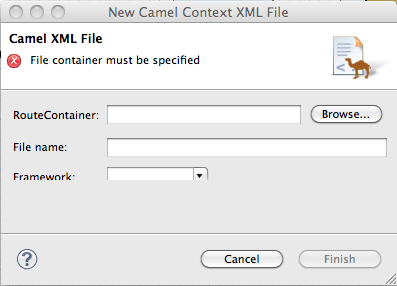Fuse 6 is no longer supported
As of February 2025, Red Hat Fuse 6 is no longer supported. If you are using Fuse 6, please upgrade to Red Hat build of Apache Camel.Chapter 3. Creating a New Camel XML file
Overview
Copy linkLink copied to clipboard!
Apache Camel stores routes in an XML file that contains a
camelContext element. The tooling includes a wizard that simplifies adding an Apache Camel context file to your project. It creates a new XML file that has all of the required namespaces preconfigured and a template camelContext element.
Procedure
Copy linkLink copied to clipboard!
To add an Apache Camel context file to your project:
- Select
from the main menu to open the Camel XML File wizard, as shown in Figure 3.1, “Camel XML File wizard”. Figure 3.1. Camel XML File wizard
- In RouteContainer, enter the location for the new file, or accept the default.You can click
 to search for an appropriate location.
ImportantThe Spring framework and the OSGi Blueprint framework require that all Apache Camel files be placed in specific locations under the project's
to search for an appropriate location.
ImportantThe Spring framework and the OSGi Blueprint framework require that all Apache Camel files be placed in specific locations under the project'sMETA-INFfolder:- Spring—
projectName /src/main/resources/META-INF/spring/ - OSGi Blueprint—
projectName /src/main/resources/META-INF/blueprint/
- In File Name, enter a name for the new context file, or accept the default.The file's name cannot contain spaces or special characters, and it must be unique within the JVM.
- In Framework, accept the default, or select which framework the routes will use:
- Spring—for routes that will be deployed in Spring containers, non-OSGi containers, or as standalone applications
- OSGi Blueprint—for routes that will be deployed in OSGi containers
- Routes—for routes that you can load and add into existing
camelContexts
- Click .The new context file is added to the project and opened in the route editor.
Related topics
Copy linkLink copied to clipboard!
| New Camel XML File |
